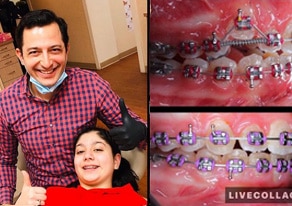Invisalign offers a convenient way to straighten teeth, but things don’t always go as planned. Invisalign emergencies, like broken or lost aligners, can disrupt treatment and cause unnecessary stress. Knowing what to do in these situations helps keep your progress on track.
Not every issue requires an urgent response, but some problems need immediate attention. Learn the common Invisalign emergencies and the best ways to handle them without delaying results.
Recognizing Invisalign Emergencies

Not all problems with Invisalign require quick action, but some do. Understanding which situations qualify as emergencies can help determine the next steps.
What Counts as an Invisalign Emergency?
Some issues can temporarily affect treatment, while others require a faster response. Here are the most common ones:
- Broken Aligners – A crack or split in an aligner may cause discomfort or prevent it from working correctly.
- Lost Aligners – Misplacing an aligner can interrupt treatment, making it important to act quickly.
- Severe Discomfort or Irritation – A damaged aligner may cause pain or irritation inside the mouth.
- Aligners No Longer Fit Properly – If an aligner feels loose or doesn’t sit correctly on the teeth, it could mean something is wrong.
Why Quick Action Matters
Ignoring an issue can slow progress and lead to longer treatment times. Wearing an ill-fitting or damaged aligner may also affect tooth movement, requiring additional adjustments later. Addressing problems as soon as possible helps avoid unnecessary setbacks.
What to Do If Your Invisalign Aligners Break
A broken aligner doesn’t always mean treatment is off track, but it’s important to handle the situation correctly. The right approach depends on how severe the damage is and how much time remains before switching to the next set.
1. Assess the Damage
Not all cracks or breaks require immediate replacement. Consider these factors:
- Minor Crack: If the aligner still fits securely and doesn’t feel uncomfortable, it may be possible to continue wearing it.
- Significant Break: If the aligner is completely split or no longer holds its shape, it won’t work as intended. A replacement is necessary.
2. Keep Wearing It If Possible
A small crack might not interfere with how the aligner functions. If it still fits snugly and doesn’t cause discomfort, wearing it until the next scheduled aligner change may be fine. However, any sharp edges or changes in fit should be taken seriously.
3. Contact Your Orthodontist for Guidance
If the break is significant, reach out to your orthodontist as soon as possible. They will recommend one of the following:
- Using the Next Set Early: If the next aligner is available and your teeth have progressed enough, switching slightly ahead of schedule might be an option.
- Wearing the Previous Set: In some cases, going back to the last aligner prevents teeth from shifting while waiting for a replacement.
- Ordering a Replacement: If neither of the above options is suitable, your orthodontist may suggest getting a replacement aligner.
4. Avoid DIY Fixes
Trying to fix a broken aligner with glue or other adhesives is unsafe. These materials aren’t meant for oral use and could create sharp edges, cause irritation, or even affect the fit of the aligner. If the break is too severe to continue using, it’s best to follow professional advice instead of attempting a repair.
Lost an Aligner? Here’s What You Should Do
Losing an aligner can feel like a major setback, but taking the right steps can minimize disruptions. Acting quickly helps keep treatment on schedule and prevents teeth from shifting out of place.
1. Check If You Have a Backup Set
Before panicking, see if you still have your previous set of aligners. Wearing the last aligner can help maintain progress while waiting for a solution. This prevents unwanted tooth movement and keeps treatment from going off course.
2. Call Your Orthodontist Immediately
Losing an aligner isn’t something to handle alone. Your orthodontist will determine the best option based on your progress. Possible recommendations include:
- Moving to the Next Set Early – If you were close to switching aligners, advancing to the next stage might be possible.
- Wearing the Previous Set – If the next aligner isn’t an option yet, going back to the last one keeps teeth from shifting.
- Ordering a Replacement – If neither option works, a new aligner may be necessary.
3. Temporarily Wear the Previous or Next Set
If your orthodontist recommends it, wearing a different set might be a short-term solution. However, it’s important to be cautious:
- Signs the Aligners Fit Correctly: No pain, excessive pressure, or looseness.
- Signs They Don’t Fit Well: Gaps, discomfort, or difficulty inserting them.
Forcing an ill-fitting aligner could cause more harm than good, so follow professional advice before switching.
4. Prevent Future Loss
Misplacing an aligner can cause unnecessary stress and delays. These simple habits can help prevent it from happening again:
- Always store aligners in their case when not in use.
- Avoid placing them on napkins, where they can easily be thrown away.
- Keep them away from pets, as dogs often chew on aligners.
Being mindful of storage habits reduces the chances of losing an aligner and keeps treatment on schedule.
Preventing Invisalign Emergencies in the Future

Taking care of aligners properly reduces the risk of unexpected issues. While some Invisalign emergencies happen by accident, most can be avoided with good habits.
1. Use a Protective Case at All Times
One of the easiest ways to prevent damage or loss is by keeping aligners in a case whenever they aren’t in use. This prevents:
- Accidental misplacement
- Pets or small children damaging them
- Aligners getting thrown away with napkins or food trays
2. Avoid Eating or Drinking with Aligners On
Invisalign aligners aren’t designed to handle the pressure of chewing. Eating with them can lead to cracks or warping. Even beverages, especially hot or sugary drinks, can cause damage or staining. Always remove aligners before eating or drinking anything other than water.
3. Handle Aligners with Care
Being rough when removing or inserting aligners can cause unnecessary stress on the material. To prevent breakage:
- Use both hands when taking them out
- Avoid bending or twisting the aligners
- Store them in a dry, cool place to prevent warping
4. Follow Your Orthodontist’s Instructions for Wear and Storage
Wearing aligners as instructed helps prevent unnecessary problems. Skipping aligners, switching too early, or failing to store them properly increases the risk of damage or setbacks. If anything feels off, checking with an orthodontist before making changes is the best way to stay on track.
When to See Your Orthodontist Right Away
Some Invisalign issues can be managed at home, but others require professional attention. If any of the following problems occur, scheduling an appointment as soon as possible is the best approach.
1. Severe Pain or Mouth Injuries
Mild discomfort is normal when switching to a new aligner, but sharp pain or irritation caused by a broken or ill-fitting aligner is not. If an aligner has rough edges or is cutting into the gums, tongue, or cheeks, an orthodontist can adjust or replace it.
2. A Major Delay in Treatment Due to Lost Aligners
Losing an aligner for a day or two may not cause major issues, but going without one for too long can impact treatment. If an aligner has been missing for several days and there’s no clear solution, contacting an orthodontist is important to prevent setbacks.
3. Repeatedly Broken Aligners
Occasional damage can happen, but aligners that keep breaking might indicate an issue with fit, wear habits, or tooth movement. If aligners are consistently cracking or splitting, an orthodontist can check for underlying problems and adjust treatment if necessary.
Ignoring these issues can lead to longer treatment times or discomfort. When in doubt, getting professional advice ensures the best outcome.
Final Thoughts
Handling Invisalign emergencies the right way helps keep treatment on schedule and prevents unnecessary complications. Broken or lost aligners don’t have to cause major delays, but quick action is key.
Staying in touch with your orthodontist, following proper care habits, and using a protective case can prevent most issues. If a problem does occur, assessing the situation and responding appropriately will minimize setbacks.
By taking care of aligners and addressing issues as they arise, treatment stays on track, leading to the best possible results.
Get Expert Care for Your Invisalign Treatment
Invisalign emergencies can be frustrating, but having the right orthodontic team makes all the difference. At Halabi Orthodontics, we provide expert care and personalized solutions to keep your treatment on track. From aligner replacements to customized adjustments, our team ensures your smile progresses without unnecessary delays.
Dr. Eli Halabi and his team use the latest technology to make orthodontic care efficient and comfortable. With a range of treatment options—including Invisalign, clear ceramic braces, and hidden lingual braces—you’ll receive a plan designed for your needs. If you have questions about your aligners or need expert guidance, Halabi Orthodontics is here to help. Contact us today to schedule a consultation.

 CURRENT PATIENT NUMBER
CURRENT PATIENT NUMBER

 What patients are saying
What patients are saying Your smile our passion
Your smile our passion News and Events
News and Events